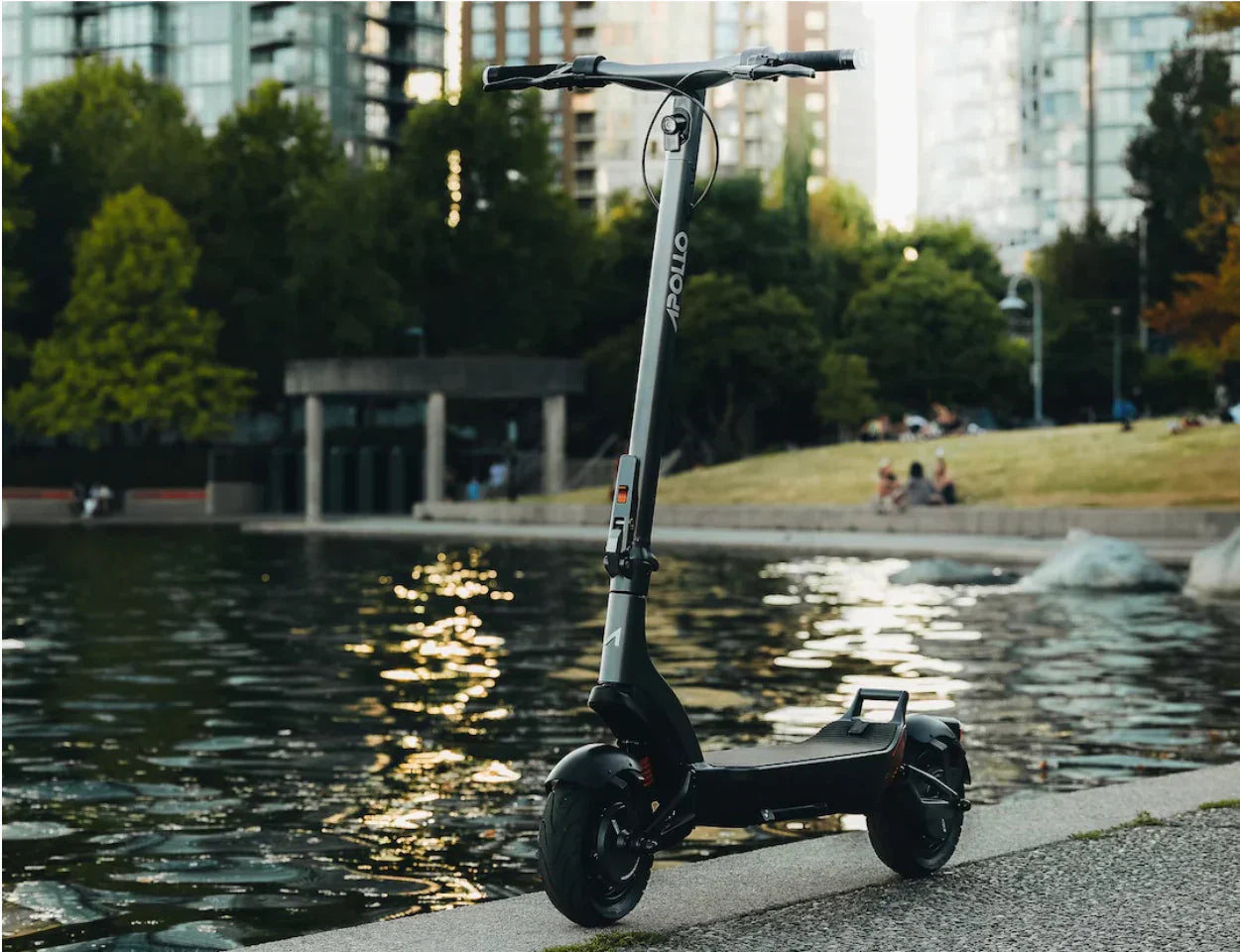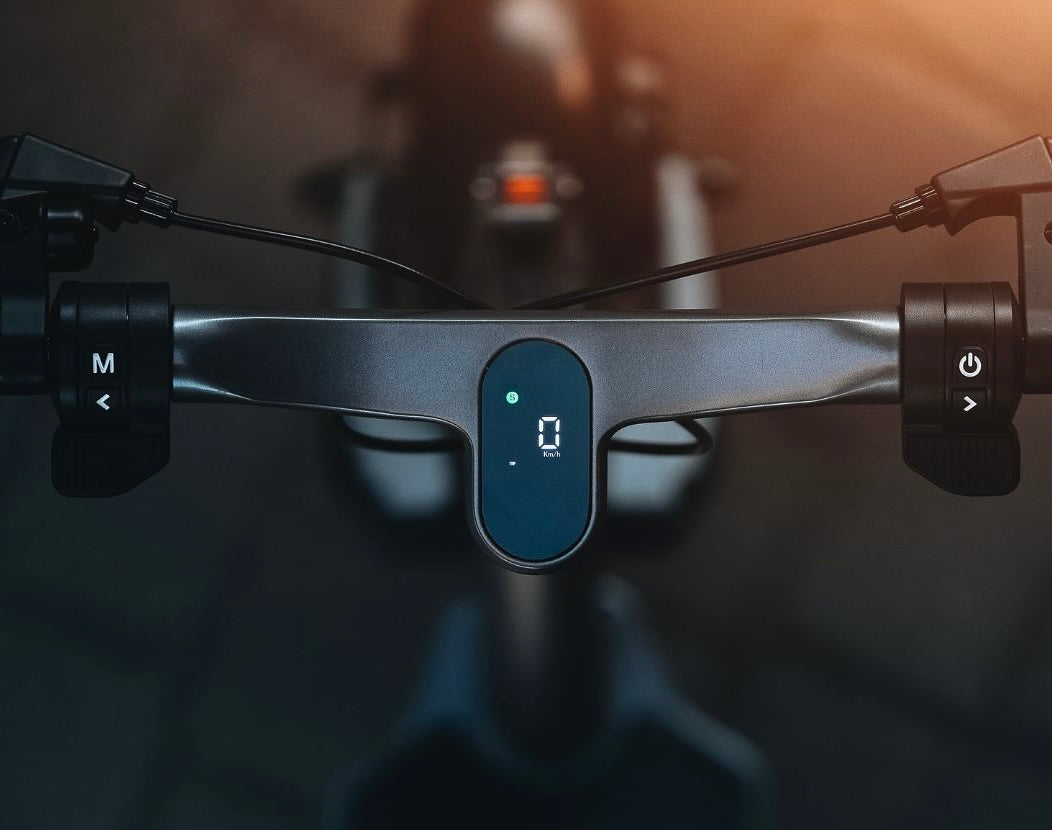One question that comes up over and over again is whether electric scooters are waterproof? The reason most people ask is that they want to know if they can ride their scooter in the rain or snow, a perfectly reasonable question when it comes to an electronic device.
The answer will depend on a few factors, which we’ll discuss more below, but we should begin by saying that there is no such thing as a fully waterproof electric scooter – at least not one that travels on land!
Instead, electric scooters have varying degrees of water resistance, from the ability to resist light rain and splashes to brief but total immersion in water. While we don’t recommend every soaking your scooter on purpose, we’ll let you know what kind of scooters can withstand a heavy storm, and how you should treat them after they get wet.

Water Resistance: Understanding the IP Ratings of Electric Scooters
The water resistance of electric scooters (and any electrical device) is measured with a code called an IP rating. IP stands for “ingress protection,” and this code rates electric devices according to how well they can withstand dirt, dust, debris, spills, and splashes.
Devices rated for outdoor use will generally have higher IP numbers, but this isn’t always the case with electric scooters. Sometimes manufacturers won’t apply for IP testing, which doesn’t mean their scooters aren’t water resistant. But since warranties don’t cover water damage, it’s better to be safe than sorry. Get a scooter with a high IP rating if you’ll be riding in wet weather.
A rating of IP54 is standard for electric scooters. The first number measures dust resistance and the second measures water resistance. Scooters rated IP54 are suitable for light rain and splashes, but you should avoid puddles and never immerse your scooter.
Scooters with an X in the dust resistance rating spot have only been tested for water resistance. You’ll see scooters rated IPX5, for example, which means they can be ridden in rainstorms. Scooters can have ratings up to IPX7.
Apollo electric scooters have some of the highest IP ratings on the market: all of the models we currently sell are rated as IP66.*
According to the IP rating scale, that means they can all tolerate dusty environments, such as dirt or gravel trails, as well as heavy rainstorms and deep puddles for a short period of time**.
*All of the most recently released versions of our scooters: Air,
Apollo Go, City, Pro and Phantom 2.0 are IP66, this excludes the Phantom V4X and older as well as repaired scooters or Open Boxes.
**Disclaimer: The water resistance rating of our products is theoretical and based on tests conducted in controlled environments. Actual performance may vary in real-world conditions. Over time, water resistance may decrease due to natural sealant wear or if the scooter is opened or modified. Riding in the rain is not recommended, as reduced grip can make it dangerous. Please note that water damage is not covered under warranty.
Tips for Riding in Wet Weather
While scooters with high IP ratings can withstand temporary immersion in water, it’s never recommended. Are electric scooters rain proof is a better question than whether they’re waterproof.
Riding electric scooters in the rain requires taking extra precautions both before and after your ride to ensure both your own safety and that of your scooter. Remember, no electric scooter is completely waterproof.
Here are some essential tips to keep in mind:
- Wear appropriate rain gear to keep yourself dry.
- Slow down and maintain a steady speed to prevent skidding on wet surfaces.
- Avoid riding through deep puddles to minimize the risk of water entering sensitive parts of the scooter.
- After riding in the rain, wipe down your scooter with a dry cloth to remove any moisture.
Additionally, it's important to check the weather forecast before heading out on your electric scooter. If heavy rain or thunderstorms are predicted, it might be best to postpone your ride to avoid hazardous conditions. Wet weather can significantly impact visibility for both you and other road users, so wearing bright and reflective clothing can help increase your visibility on the road.
Discover Electric Scooter Storage Tips
Another tip to consider is to inspect your scooter regularly for any signs of water damage, such as rust or corrosion. Pay close attention to the electrical components and connections, as water ingress can cause malfunctions or even permanent damage. Applying a water-resistant coating or silicone sealant to vulnerable areas of your scooter can provide an extra layer of protection against moisture.

The Impact of Water Damage on Electric Scooter Performance
Water damage can have severe consequences on the performance of electric scooters. Excessive exposure to water can cause corrosion and rust on crucial components such as the battery, motor, and electronics. This can lead to decreased performance, reduced battery life, and potentially even render the scooter inoperable.
It is important to note that while most electric scooters are designed to handle light rain and wet conditions, they are not designed to be completely submerged in water. Therefore, it is crucial to exercise caution and avoid exposing your scooter to excessive amounts of water.
Explore Tips and Insights on Riding Your Electric Scooter Across Different Terrains
One of the most vulnerable parts of an electric scooter when it comes to water damage is the battery. Water can seep into the battery compartment and cause irreversible damage, leading to a decrease in battery efficiency and overall scooter performance. In addition, water can also damage the electrical connections within the scooter, leading to short circuits and malfunctions.
Furthermore, the motor of an electric scooter is also at risk of water damage. Water can cause the motor to seize up or malfunction, resulting in a loss of power and reduced speed. This can not only affect the performance of the scooter but also pose a safety hazard to the rider.

Testing the Limits: How Much Water Can an Electric Scooter Handle?
Many electric scooters claim to be waterproof, but it's essential to understand their limitations. To determine how much water an electric scooter can handle, it's crucial to consider both the IP rating and the manufacturer's guidelines.
In general, electric scooters with higher IP ratings, such as IP65 or IP66, offer better protection against water. However, it is important to remember that these ratings are based on laboratory tests and may not always translate to real-world conditions. Always avoid submerging your electric scooter in water, even if it has a high IP rating, as this can still result in water damage.
Aside from the IP rating, another factor to consider is the design of the electric scooter. Some scooters have additional features like sealed battery compartments and waterproof connectors, further enhancing their water resistance. These design elements can provide an extra layer of protection, especially in rainy or wet conditions.
Furthermore, regular maintenance is key to ensuring the longevity of your electric scooter's water resistance. Inspecting and replacing worn-out seals, keeping connectors clean and dry, and storing the scooter in a dry environment when not in use can all contribute to maintaining its water-resistant properties over time.

Maintenance Guide: Keeping Your Electric Scooter Safe from Water Damage
To ensure your electric scooter remains as water-resistant as possible and to prolong its lifespan, regular maintenance is key. Here are some maintenance tips to prevent water damage:
- Regularly inspect and tighten any loose or exposed connectors.
- Keep your scooter clean and dry by wiping it down after riding in wet conditions.
- Avoid storing your scooter in damp or humid environments. Always store your scooter indoors, if possible. If you must store it outdoors, invest in a waterproof cover to keep it warm and dry.
- Follow the manufacturer's maintenance guidelines and schedule regular check-ups.
Water damage can significantly impact the performance and safety of your electric scooter, seeping into electrical components and causing corrosion and short circuits. This can lead to malfunctions or even permanent damage to your scooter's motor, battery, or other crucial parts. By following a regular maintenance routine and taking precautions to protect your scooter from water exposure, you can extend its longevity and prevent water damage.



















